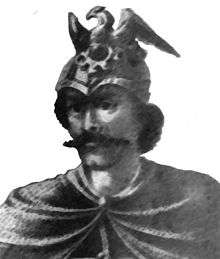Pavle of Serbia
| Pavle | |
|---|---|
| Prince of the Serbs | |
 | |
| Prince of Serbia | |
| Reign | 917–921 |
| Predecessor | Petar |
| Successor | Zaharija |
| Born |
ca. 870 Ras |
| Died | 921 |
| House | Vlastimirović |
| Father | Bran |
| Religion | Eastern Orthodox Christianity |
Pavle (Serbian: Павле, Greek: Παῦλος[a]; c. 870–921) was the Prince of the Serbs from 917 to 921. He was put on the throne by the Bulgarian Tsar Symeon I of Bulgaria, who had imprisoned the previous prince, Petar, after he had become a Byzantine ally. Pavle ruled for four years, before being defeated by Zaharija, his cousin. Pavle was the son of Bran, the middle son of Mutimir (r. 851–891) of Vlastimirović dynasty.[1]
Pavle was born in the 870s,[2] between 870 and 874[3] to Bran Mutimirović, the middle son of Mutimir. His Christian name, in relation to the previous generation of pagan names, shows the spread Christianization of Serbs.[4] After Mutimir, his grandfather, had died in 891, Pribislav succeeded as prince. Pribislav ruled briefly for a year, when Petar returned and defeated him. Pribislav fled to Croatia with his brothers Bran (Pavle's father) and Stefan.[5] Bran later returned and led an unsuccessful rebellion against Petar in 894[6] Bran was defeated, captured and blinded (as per Byzantine tradition).[7]
| Vlastimirović dynasty |
|---|
In 917, a Byzantine army led by Leo Phokas invaded Bulgaria, but was decisively defeated at the Battle of Achelous on 20 August 917.[8] After Achelous,[6] Symeon sent an army to Serbia led by Pavle (after he had heard of a Byzantine–Serbian alliance), to take the Serbian throne, however, unsuccessfully as Petar proved a good opponent. Symeon then sent generals Marmais and Theodore Sigritsa, persuading Petar (through an oath) to come out and meet them, then captured and took him to Bulgaria where he was put in prison, dying within a year.[6] Symeon put Pavle on the Serbian throne.[6]
In 920, Zaharija, the exiled son of Pribislav (the eldest of Mutimir's sons), was sent by Romanos I Lekapenos (r. 920–944) to seize the throne. Zaharija was the rightful pretender. Pavle defeated and captures him, handing him over to Symeon, where he is held for future tactics. In the meantime, Pavle switches to Byzantine support and Symeon now dispatches Zaharije with Bulgarian troops in 921. Zaharija wins the battle, and quickly revows his Byzantine alliance. There are no more mentions of Pavle.
See also
| Wikimedia Commons has media related to Vlastimirović dynasty. |
Annotations
- ^ His name is attested as Greek Paulos (Παῦλος). In historiography, he is known as Pavle Branović (Павле Брановић).
References
- ↑ Ćirković 2004, pp. 18.
- ↑ Živković 2006.
- ↑ Veselinović & Ljušić 2008.
- ↑ A. P. Vlasto (2 October 1970). The Entry of the Slavs Into Christendom: An Introduction to the Medieval History of the Slavs. CUP Archive. pp. 209–. ISBN 978-0-521-07459-9.
- ↑ Fine 1991, p. 141.
- 1 2 3 4 Fine 1991, p. 150.
- ↑ Ferjančić 1966.
- ↑ Fine 1991, p. 149.
Sources
- Primary sources
- Moravcsik, Gyula, ed. (1967) [1949]. Constantine Porphyrogenitus: De Administrando Imperio (2nd revised ed.). Washington D.C.: Dumbarton Oaks Center for Byzantine Studies.
- Secondary sources
- Ćirković, Sima (2004). The Serbs. Malden: Blackwell Publishing.
- Ćorović, Vladimir (2001). Istorija Srpskog Naroda [History of the Serb People] (in Serbian) (Internet ed.). Belgrade: Ars Libri.
- Ferjančić, Božidar (1966). Vizantija i Južni Sloveni [Byzantium and the South Slavs] (in Serbo-Croatian). Belgrade: Zavod za izdavanje udžbenika Socijalističke Republike Srbije.
- Fine, John Van Antwerp Jr. (1991) [1983]. The Early Medieval Balkans: A Critical Survey from the Sixth to the Late Twelfth Century. Ann Arbor, Michigan: University of Michigan Press.
- Novaković, Relja (1981). Gde se Nalazila Srbija od VII do X Veka [Where Serbia was situated from the 7th to 10th centuries]. Serbia, Belgrade: Narodna knjiga. pp. 61–63.
- Ostrogorsky, George (1956). History of the Byzantine State. Oxford: Basil Blackwell.
- Runciman, Steven (1930). A History of the First Bulgarian Empire. London: G. Bell & Sons.
- Runciman, Steven (1988) [1929]. The Emperor Romanus Lecapenus and His Reign: A Study of Tenth-Century Byzantium. Cambridge: Cambridge University Press.
- Stephenson, Paul (2000). Byzantium's Balkan Frontier: A Political Study of the Northern Balkans, 900–1204. Cambridge: Cambridge University Press.
- Treadgold, Warren T. (1997). A History of the Byzantine State and Society. Stanford, CA: Stanford University Press.
- Veselinović, Andrija; Ljušić, Radoš (2008). Srpske dinastije. Službene glasnik. ISBN 978-86-7549-921-3.
- Живковић, Тибор (2002). Јужни Словени под византијском влашћу 600-1025 (South Slavs under the Byzantine Rule 600-1025). Београд: Историјски институт САНУ, Службени гласник.
- Živković, Tibor (2006). Portreti Srpskih Vladara (IX—XII Vek) (in Serbian). Belgrade. ISBN 86-17-13754-1.
- Živković, Tibor (2008). Forging unity: The South Slavs between East and West 550-1150. Belgrade: The Institute of History, Čigoja štampa.
- Živković, Tibor (2013a). "On the Baptism of the Serbs and Croats in the Time of Basil I (867–886)" (PDF). Studia Slavica et Balcanica Petropolitana (1): 33–53.
- Živković, Tibor (2013b). "The Urban Landcape of Early Medieval Slavic Principalities in the Territories of the Former Praefectura Illyricum and in the Province of Dalmatia (ca. 610-950)". The World of the Slavs: Studies of the East, West and South Slavs: Civitas, Oppidas, Villas and Archeological Evidence (7th to 11th Centuries AD). Belgrade: The Institute for History. pp. 15–36.
External links
Pavle Born: 870–874 Died: Unknown | ||
| Regnal titles | ||
|---|---|---|
| Preceded by Petar |
Prince of Serbia 917–921 |
Succeeded by Zaharija |